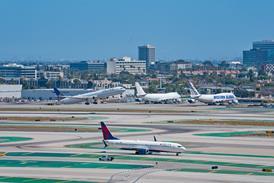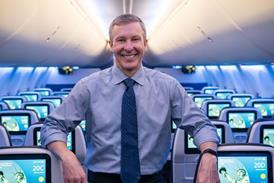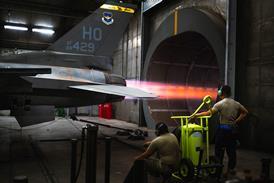Airbus is advancing cockpit, systems and manufacturing technologies
David Learmount/LONDON
Airbus Industrie has blasted its way into a market effectively monopolised by the USA by using radical technological innovation in the flightdeck, flight control systems, materials and manufacturing techniques. The A380 launch brings another step-change in the application of high technology. It has to, or perhaps face continued Boeing dominance.
In the early 1970s, Boeing, Lockheed and McDonnell Douglas already offered the marketplace high-quality products. What is more, they had earned brand loyalty and provided a visible customer support system. To breach the Americans' solid market defences, Airbus needed products with the penetrating characteristics of an armour-piercing shell.
But the first product was not armour-piercing. The A300 series went for a chink in the armour - the Americans did not offer a widebody twinjet. But by 1978 Boeing had launched the 767, which entered service in 1982 to close the gap.
Airbus' next target was more difficult: the narrow chink between the incredibly popular, growing 737 family and the well-established 757. The A320 had to be able to offer something different, and it did. With digital fly-by-wire (FBW) and flight envelope protection, it gave customers the aircraft control systems of the future, and made extensive use of carbon fibre reinforced plastic (CFRP) in the aircraft's primary and secondary structures.
At entry into service in 1988, the A320, with its revolutionary sidestick for pilot manual control, made few concessions to tradition in the aircraft's direct control interface, as the 777 did with its full-size control column and artificial feel system, despite the fact that Boeing's new machine was also FBW. Sidesticks are retained on the A380, but this aircraft will be the first Airbus to dispose of the mechanical pitch-trim wheel.
Cross crew qualification
The company now faces the task of maintaining an A380 flightdeck that allows cross-crew qualification across the full Airbus FBW range of types, while taking advantage of the latest man-machine interface possibilities and fully integrated avionics and flight management systems (FMS).
But there is no need to compromise, says A380 chief engineer Robert Lafontan. The same visual information will be there in much the same basic format, except that the units themselves will be liquid crystal display (LCD) flat panels instead of cathode ray tubes (CRT) - but the displays will be interactive and more intuitive. Lafontan predicts that an A330 or A340 pilot will need an 8 to 10-day "differences" course to convert to the A380.

The new interface system is designed to make the entry of - and access to - data far less cumbersome. Out will go the old centre-pedestal control and display units (CDU) - the traditional interface with the FMS which is the bane of pilots' lives during their early conversion to glass cockpits - and in will come a keyboard/ pointing-device system on a pull-out platform directly in front of each pilot.
So the new FMS interface will be the keyboard and a point/click system, the precise hardware for which is still under definition. The cursor/pointer could be controlled by a ball or a touch-pad, but touch-screen interaction has been rejected, says Lafontan. The keyboard offers much quicker data entry - whether frequencies, waypoints, letters or figures - than the old one-hand CDU. Because it will be possible to command more modes/functions on-screen, there will be fewer push-button controls in the flightdeck , just as the A320 appeared with far fewer control panel switches/buttons than its rival.
As in the other FBW Airbuses, the basic displays will consist - for each pilot - of flight and navigation displays, and the two electronic centralised aircraft monitor (ECAM) displays will be shared. One of the ECAM screens will show the engine data, the other the aircraft configuration and systems status, with checklists, warnings and emergency data sharing the remaining space on the two displays.
During taxiing, the database in the A380's fully backed-up central server, known as the onboard information system (OIS), will be able to show on the navigation display a full airport plan with a moving aircraft symbol indicating the aircraft's position. This should lower stress levels at the world's more complex large airports, and even contribute to reducing dangerous runway incursions.
The pilots will also be able to "see", via external cameras, the aircraft's main and nose gear on the taxiway/runway, which will help to reduce the chances of letting the wheels stray off the hard surface during tight turns. Lafontan says it is essential that the aircraft's turning radius is no greater than current large aircraft, so the main gear units will be steerable.
The primary engine parameter delivered on the ECAM will be the thrust output, shown as a percentage of the maximum, which enables pilots to see whether the engine is operating below par when full power is demanded. The A380 will also have a real-time digital take-off performance monitoring system, but the way in which information is presented to the pilots so as not to distract them is still being finalised.
The idea now being considered, says Lafontan, is an acceleration monitoring system which provides a "snapshot" of acceleration performance at a significant point during the take-off run: for example 80 or 100kt (150 or 185km/h), and possibly the runway distance remaining against stopping distance. This could be delivered aurally or visually, to be checked by the pilot not flying.
Each navigation display will include a vertical flight profile in its lower sector, showing aircraft height compared with minimum safe altitudes en route, and climb or descent trajectories compared with the published profile and terrain. This vertical "cut", along with all the other modes of information display and interface, is still being assessed by a group of 21 pilots from customer and potential customer airlines, so precisely what it will show and how it is displayed are still being refined, says Lafontan.
A "three-dimensional" perspective on the main display is also possible, he says, but the vertical cut, shown as a standard left-to-right graphic, is the most popular choice at present. The final decision will be frozen this year.

One aim is to make the A380 flightdeck a totally paperless environment, with the possible exception of charts and approach/departure plates - but the latter could be printed out on board. There will be no more need for bulky pilot bags, says Lafontan, because all checklists, aircraft manuals, performance data, loadsheets, weight and balance information, diagnostic systems, notices to airmen, other aeronautical information and the aircraft technical log will be loaded into the OIS. The OIS could theoretically be updated in real time by datalinking from the ground, but in practice it is more likely to be updated via a gatelink system at airports. Lafontan says the OIS upload system does not have to be chosen yet, but it will be "the best available by 2005".
No differences
As for the aircraft as an operating system for pilots to manage, Lafontan says there will be "no major handling differences" from the earlier FBW Airbuses. There will be a completely new automated air-conditioning system, and the electrical systems will be variable frequency.
Hydraulically operated control surfaces, controlled by the FBW system, will be powered by a two-layer system. The first layer is a conventional hydraulic network direct to actuators, except that the pressure will be much higher at 5,000psi (345 bar) compared with 3,000psi. The second is a system of electric pumps, sited by the actuators which generate the hydraulic power to operate them.
All control axes will have both hydraulic and electro-hydraulic systems, either of which will operate the control surfaces independently.
To win 747 customers over to the new aircraft, Airbus must not only make it easier to operate, but also lighter, stronger and cheaper to fly and maintain. CFRP is used extensively (see diagram) for primary structures where it has never been used before, such as the centre wing box, the rear pressure bulkhead and the outer wing sections.
A glass fibre/aluminium laminate called GLARE will be used for the cargo compartment floor and the upper fuselage panels. This has a particularly good strength/density ratio, is highly impact resistant, and has a higher burn-through resistance than aluminium. Stringers on the aluminium fuselage sections will be laser-welded, rather than riveted to the fuselage plates, which is faster to do and makes it stronger and up to 10% lighter.
Airbus does not intend to stop there. Its European partner companies are running a materials research and development programme, TANGO (technology applications to near-term business goals and objectives) aimed at continually pushing design horizons to reduce manufacturing and maintenance costs while improving materials performance.
Source: Flight International























